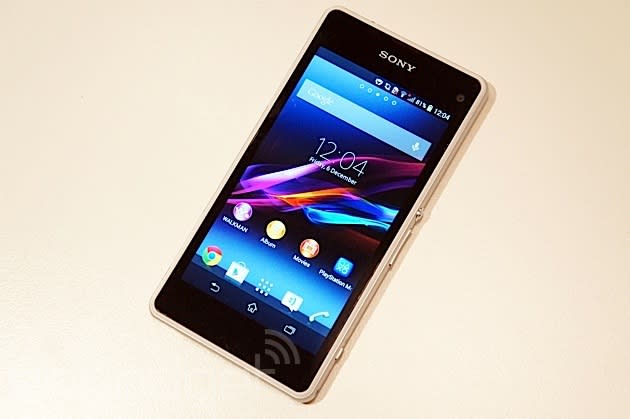Sony announces Xperia Z1 compact, a smaller flagship with full-size features

At last year's CES, Sony introduced us to the Xperia Z, which would be its flagship phone for most of 2013, until the Xperia Z1 was unveiled at IFA. Here at CES 2014, Sony is giving the Z1 some company at the top, as it introduces the Z1 compact. Yes, don't call it a mini; Sony is very keen to distance itself from the current trend of, what it considers, watered-down versions being sold as mini-flagships. As such, the Z1 compact is almost entirely identical to the original, with the same quad-core Snapdragon 800, the same 20-megapixel camera and the same waterproof design, just this time with a 4.3-inch screen, oh, and color options! We spent a few moments with it ahead of today's announcement to find out if it lives up to Sony's "no compromise" boasts. Head past the break to find out.
Usually at this point, we'd reel off the key specifications, but in this case we're going to start with what's different between the Z1 compact and the full-fat version. Obviously, the main distinction is the screen size, down from five to 4.3 inches. Given that the whole point is to make a smaller version, this key lower specification (numerically speaking) isn't to be seen as a compromise. It's worth pointing out that the smaller (now IPS) display also brings a drop from 1080p to 720p resolution (the ppi is still a solid 340 though). The next main difference is the battery. The Z1 compact comes with a 2,300mAh cell, down from the 3,000mAh battery in the larger version, but given the lower power requirements from that reduced amount of screen, Sony is confident you'll get a similar amount of battery life overall. The Z1 compact also comes with Android 4.3 straight out of the box.

So, the rest of the specifications are just as you'd find in the original Z1. That means you get a 20.7-megapixel (1/2.3-inch) main camera, Triluminos display with X-Reality engine, 2.2GHz of Snapdragon 800 quad-core goodness, NFC (Sony isn't shy when it comes to NFC), and 16GB of onboard memory (there's a microSD card slot, too). All of the above with the same IP58 level of waterproofing -- something of an Xperia trademark these days. But what about the color options we hear you cry? Well, there's black and white for the monochrome fans, and a rather loud lime (which looked quite yellowish to us) as well as a fairly hot-pink hue. The colors look bright and bold, and even extend to the milled aluminum parts. So, where the plum-colored Z1 was broken up by the metal sections, this time around, the phone is one color throughout. The yellow lime version gets almost a goldish tone on its metal parts, and the metallic parts of the pink version also stand out.
Sony, and in particular the Xperia line of phones, isn't noted for swift and dramatic design moves, and there is unsurprisingly even less deviation this time around. It's clear the company wanted to make a mini compact version of the Z1 as faithfully as possible, and by and large, it's done just that. That said, the Z1 compact is -- gasp -- a whole millimeter thicker than its sibling, but as you can imagine, that's mostly down to cramming much of the same hardware into a more diminutive frame.

Our impressions, from the short time we had with the handsets, are that this is a promising step from Sony. The Z1 compact feels just as well-built as its larger counterpart, and the user experience is, obviously, much the same. The display is even arguably an upgrade (unless 1080p is a must for you), thanks to Sony plumping for an IPS panel, improving those much-maligned viewing angles. The choice of colors will only serve to broaden its appeal, and while it's a little wild, we kinda like the lime.
The reduction in display size makes the Z1 compact feel a lot easier to use one-handed, and we can see this really appealing to folks who like the form factor of, say, the iPhone, but are in the market for an Android. While we're on the subject, Sony is clearly hoping to steal a few of Apple's customers along the way by providing a cable (potentially in the box) that will make transitioning from the iPhone to the Z1 compact a snap -- literally by directly connecting the two phones. The software on the handsets we saw isn't final, so we're unable to pass full judgment, but given its hardware capabilities, and the few moments we did have with it, the Z1 compact promises to fly like a rocket. It also comes with all those social-camera goodies that were introduced with the original Z1, which is great news for those who want those augmented reality dinosaurs (or the other, more useful, camera tricks).

Most importantly, Sony has pleased us by taking the approach that many of the other big-name phone makers seem unusually reluctant to do -- to make a mini compact flagship, with the same -- or as reasonably close as possible -- specifications as the handset it mimics. Some people will love the Z1 compact (it ticks a lot of boxes after all); others might not fancy it, but above anything else, we hope it steers the mini-mobile trend in the direction many would have liked to see it go in the first place. You can get your hands on one mid-February, and while Sony is keeping tight-lipped on the price for now, it'll likely come in somewhere between other existing "minis" and the full-sized Z1.
































